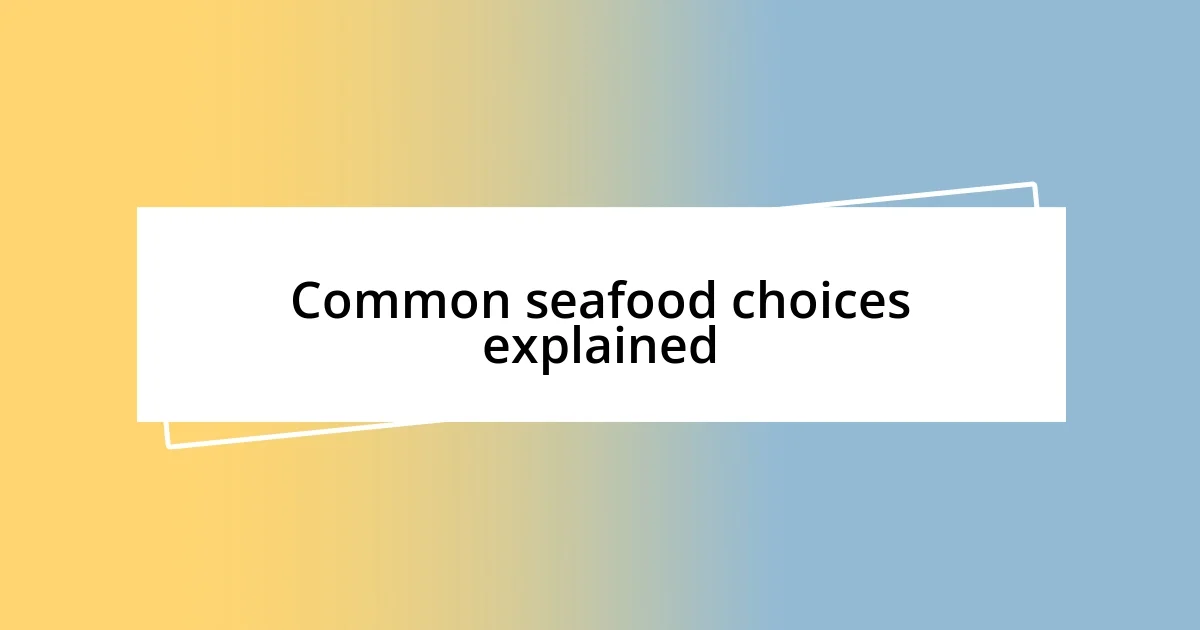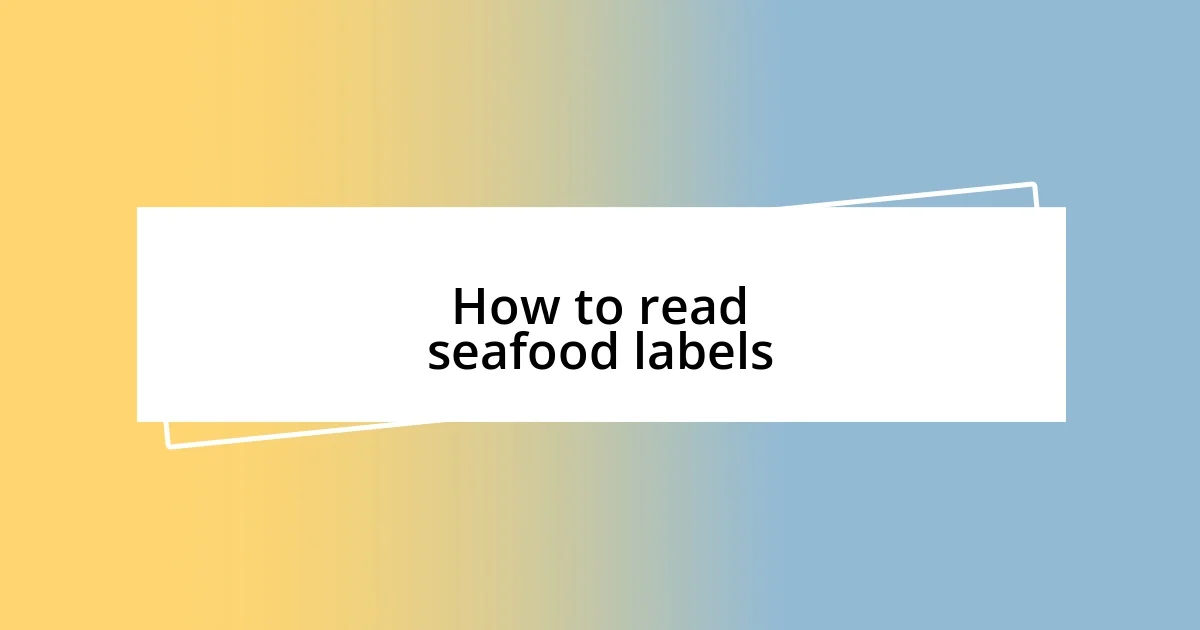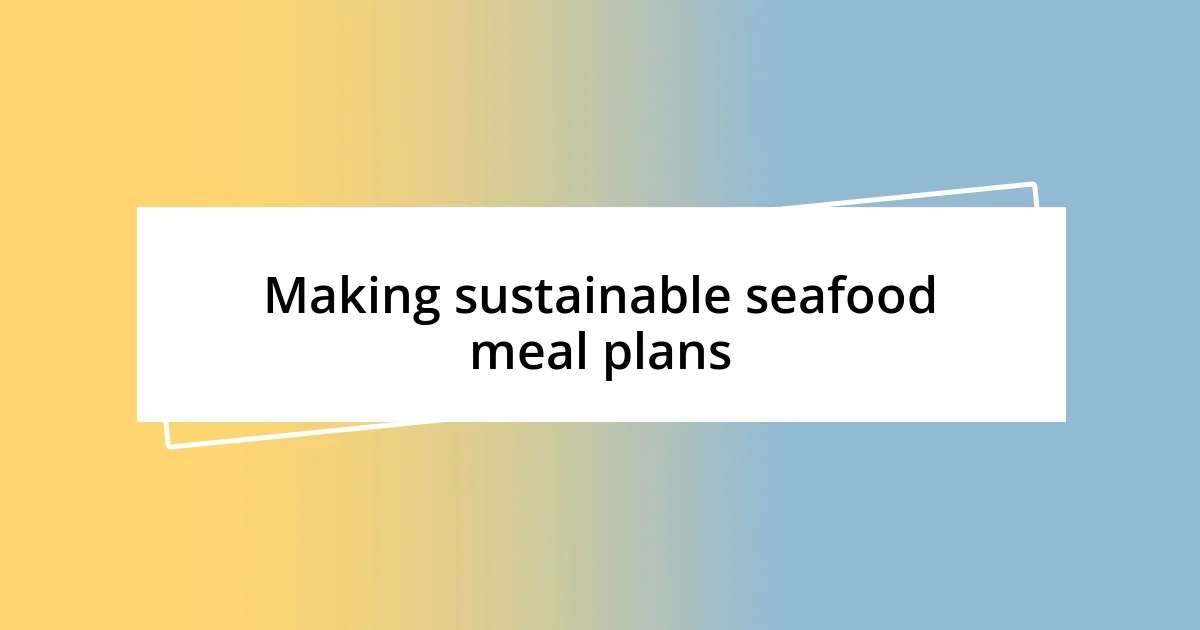Key takeaways:
- Sustainable seafood choices play a crucial role in protecting marine ecosystems and ensuring long-term fish populations, linking personal consumption habits to broader environmental health.
- Understanding labeling and sourcing practices, such as seeking certified labels (MSC or ASC), helps consumers make informed decisions about the sustainability of their seafood purchases.
- Meal planning around seasonal seafood not only diversifies diets but also promotes environmental responsibility by supporting healthier fish populations and local fisheries.

Understanding sustainable seafood choices
Understanding sustainable seafood choices is all about recognizing the balance between enjoying seafood and protecting our oceans. Have you ever caught yourself staring at the seafood counter, wondering where that fish came from? I remember a time when I was perplexed by the myriad of labels, all promising sustainability but feeling overwhelming at the same time. It made me realize how crucial it is to seek clarity in seafood origins.
The term “sustainable seafood” commonly refers to fish and shellfish caught or farmed in ways that consider the long-term health of the species and the ocean ecosystem. It’s not just a label; it’s about ensuring our seafood choices don’t contribute to overfishing or harmful practices. I often feel a sense of responsibility when I choose my seafood; it’s a reminder that every bite can support the health of our oceans or contribute to their decline.
While exploring sustainable options, I learned the importance of terms like “wild-caught” and “farm-raised.” Each has its pros and cons. Have you ever thought about the environmental impact of farming fish? Personally, I find it intriguing to weigh the benefits of local fisheries versus global supply chains. Understanding these choices can transform not only our dinner plates but also the future of marine life.

Importance of seafood sustainability
The significance of seafood sustainability cannot be overstated; it’s about ensuring that our oceans remain vibrant for future generations. I recall a moment fishing with my father, marveling at the abundance of life beneath the waves. That experience ingrained in me the understanding that our enjoyment of seafood must not come at a cost to marine ecosystems. Sustainable seafood practices protect not only the fish populations but also the livelihoods of those who rely on fishing for their income.
Here are some key reasons why seafood sustainability matters:
- Protecting Marine Life: Sustainable practices help to maintain healthy populations of fish and other marine species, ensuring they can thrive.
- Preventing Overfishing: By choosing sustainable options, we help mitigate the risk of depleting fish stocks and risking extinction.
- Safeguarding Ecosystems: Healthy oceans contribute to balanced ecosystems, which benefits all forms of life, including humans.
- Supporting Local Communities: Buying sustainable seafood often means supporting local fishermen and communities that engage in responsible practices.
- Healthier Seafood Choices: Sustainable seafood is usually sourced with less antibiotic and chemical interference, making it a healthier option for consumers.
These aspects highlight how each choice we make is intertwined with the broader health of our oceans. Each time I pick a sustainable option at the market, I feel like I’m contributing to a collective effort to safeguard our aquatic resources.

Common seafood choices explained
When it comes to common seafood choices, understanding the differences is essential. For instance, wild-caught fish are often lauded for their natural diets and lower environmental impact, while farm-raised fish can offer more consistent supply levels. I remember the first time I tried salmon from a local fishery; the taste was remarkable, but I also learned about the challenging practices involved in some larger-scale farms. This experience taught me to pay closer attention to my choices.
Another common choice is shrimp, which can be found both wild and farmed. However, I often reflect on how much of the shrimp available mirrors murky practices due to overfishing and habitat destruction. I once attended a seafood festival that featured a shrimp from a sustainable farm, which made me reconsider my preferences and their environmental consequences. It’s fascinating to think about how one choice can align with sustainable practices and support healthier ecosystems.
Tuna is another seafood staple, but the overfishing crisis surrounding certain types, like bluefin tuna, has pushed me to look for options labeled as sustainably sourced. After discovering that many tuna stocks are on the brink of collapse, I made a promise to only purchase species that are certified by organizations dedicated to sustainability. This change in my shopping habits truly embodies the idea that I have the power to impact marine health through my everyday decisions.
| Seafood Type | Wild-Caught Benefits | Farm-Raised Considerations |
|---|---|---|
| Salmon | Natural diet, often higher omega-3s | Consistent supply, possible antibiotic use |
| Shrimp | Variety of catch methods, mixed impacts | Risk of habitat destruction, sustainability varies |
| Tuna | Wild populations can maintain balance | Can help alleviate pressure on wild stocks but watch for overfishing |

Identifying sustainable seafood sources
Identifying sustainable seafood sources can feel daunting, but there are clear signs to look for. When I shop, I always check for labels or certifications like the Marine Stewardship Council (MSC) or the Aquaculture Stewardship Council (ASC). Those symbols assure me that the seafood has met rigorous sustainability standards, which provides peace of mind for both my conscience and my plate.
Another effective strategy is to ask questions. When I visit my local fish market, I’m not shy about inquiring where the seafood comes from, how it was caught or farmed, and whether the practices are environmentally friendly. The more I engage with vendors about their sourcing practices, the more I feel connected to the food I consume and its impact on our oceans. Have you ever thought about how much more informed you could be just by having these conversations?
Additionally, I pay attention to seasonality when selecting seafood. Some species are more plentiful at certain times of year, which influences their sustainability. I recall visiting a seafood festival where a chef highlighted seafood that was in season, showcasing the flavors of the month. It not only tasted great but also made me realize that choosing seasonal options can help balance fish populations. It’s amazing how much a little awareness can enhance both our culinary experiences and our commitment to sustainability.

How to read seafood labels
Reading seafood labels can seem overwhelming at first, but I’ve found it to be a powerful tool in making informed choices. For example, I was surprised to learn that “sustainably harvested” doesn’t always guarantee a good environmental impact. I now look for specific certifications, like those from the Marine Stewardship Council, because they signify that the seafood meets strict sustainability guidelines. Have you noticed how some labels can be vague or misleading?
I recall once standing in front of a seafood display, pondering over a package labeled “wild-caught.” After digging deeper, I discovered that not all wild-caught fish are created equal, with some sourced from overfished areas. It was a real eye-opener! Now, I make it a habit to read the fine print, checking for information about the fishing methods used. I ask myself, does this product uphold ethical standards? If it doesn’t, I put it back on the shelf.
Another tip I often share with friends is to pay attention to the country of origin. When I learned that some fish from certain countries are often linked to unsustainable practices, it changed how I approached buying seafood. I remember a time I chose a beautiful piece of cod from a local source—it tasted fresher and more vibrant than any imported option. I couldn’t help but feel good knowing it was sustainably sourced, leading to both culinary satisfaction and peace of mind. What does your seafood shopping say about your values?

Practical tips for buying seafood
When I’m out buying seafood, the first thing I do is check for those helpful labels that assure me of its origins. I remember a time I picked up a package with the MSC label, and it felt like an instant connection; I knew I was supporting responsible practices. How often do we overlook these small details that can lead to significant impact?
Another practical tip I’ve learned is to develop a relationship with local fishmongers. One time, I struck up a conversation with a vendor at my local market. The stories he shared about the fishermen and their sustainable methods made my selection process feel much more personal. It’s amazing what you can discover when you simply ask for more information; it turns grocery shopping into a richer experience.
Lastly, I make it a point to establish a budget for my seafood purchases. There’s a common misconception that sustainable seafood is always more expensive, but that’s not always true. When I first started prioritizing sustainability, I felt the pinch. But over time, I learned to seek out deals and sales on local, sustainable options that fit my budget. Have you ever discovered a hidden gem while staying within your financial limits? You might be surprised at what’s out there!

Making sustainable seafood meal plans
When I plan my meals around sustainable seafood, I start by mapping out what I’ll cook for the week. One time, I decided to feature a different type of fish for each day, and it sparked my creativity in the kitchen. Preparing meals this way not only keeps my diet diverse but also helps me make conscious choices about what I’m consuming. Have you ever noticed how meal planning can transform your perspective on food?
Incorporating seasonal seafood into my meal plans has become a game-changer for me. For example, I learned that certain species are more abundant at specific times of the year, allowing me to support healthier ocean ecosystems. One evening, I made a delightful shrimp stir-fry when I discovered shrimp from a local fishery was in season. It’s hard to describe how satisfying it was to enjoy a fresh dish while knowing I was contributing to sustainability efforts. Doesn’t it feel great when our choices align with our ethics?
I also love to set reminders for myself to check new recipes that highlight sustainable options. Recently, I stumbled upon a fantastic recipe for baked pollock, which I hadn’t tried before. It was simple, delicious, and left me feeling accomplished knowing I was making a positive impact on the environment. Do you ever find new foods you didn’t realize could also be a sustainable choice? Exploring such avenues makes sustainable eating an exciting journey rather than a restriction.














